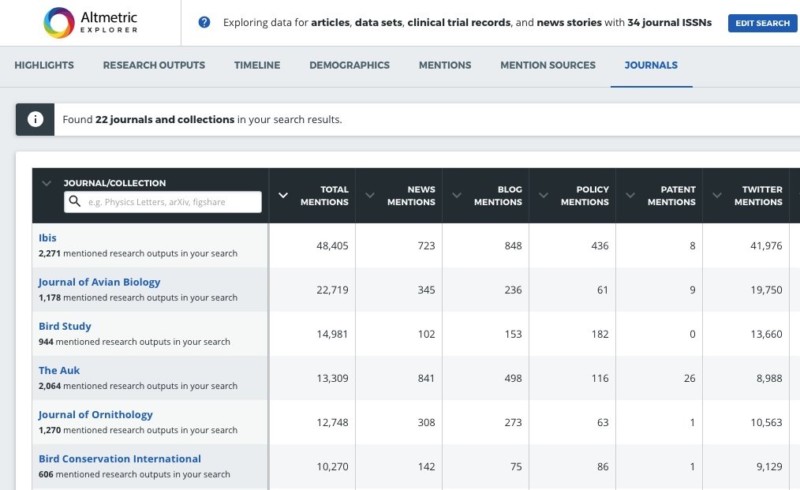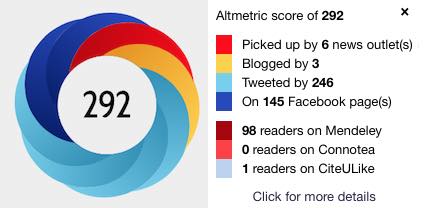LINKED PAPER
How social are ornithologists?. 2016. Dudley, S. & Smart, J. IBIS. DOI: 10.1111/ibi.12403. VIEW
Do you care about your research?
Do you want your latest paper to reach the widest possible audience?
Of course you do! So read on . . .
In recent blogs I’ve explained how links to research papers from social media and blogs contribute to a paper’s Altmetric Attention Score. This score is aggregated from all online mentions of a research article including online media sites (e.g. Phys.org, ScienceDaily.com). What is Altmetric?
In our recent paper (Dudley & Smart 2016) we showcased how the RSPB Centre for Conservation Science used altmetric data to measure the outreach of their science. This was done by comparing the combined scores of RSPB papers over three years and comparing them to the performance of journals over the same period (figure 1). This illustrates how with strategic online promotion the RSPB was able to increase the online attention of their research articles and so drive their overall Altmetric Attention Scores.
Figure 1. The change in the mean Altmetric Attention Score (±95% CIs) from 2013–2015 for all published papers in three ornithology journals, Bird Study (light grey), Ibis (mid grey), Journal of Avian Biology (dark grey) and from the RSPB Centre for Conservation Science for papers in in any ornithology journal (light blue) and those in all journals (dark blue). Altmetric Attention Scores gathered 8 July 2016 accessed from journal web pages.
From Dudley & Smart 2016
Driving a paper’s online attention and Altmetric Attention Score
Most ornithology journals’ Altmetric scores are largely made up from social media (mainly Twitter) and blogs (table 1). Whilst journals and societies can lead on this, the role authors can play is also key. Author-penned blogs perform much better than third-party blogs, and authors can also help, often hand in hand with their journal or publishing society, on social media to help drive their papers’ reach and online attention. As can be seen in table 1, IBIS is the highest Altmetric scoring ornithology journal (at 31 Dec 2015) and leads the way in four of the five contributing streams listed.

Twitter can be a very important contributor to a paper’s Altmetric Attention Score. Table 2 shows the Twitter output and reach for IBIS’s two top scoring Altmetric papers from 2015. For each paper the BOU’s tweets and subsequent retweets combined contributed 32% and 45% respectively of the overall Twitter activity for these two papers.

The corvid paper (table 2) is IBIS’s highest scoring Altmetric paper of all time. This was achieved largely by one of the authors who drove the online attention around this important paper via news media, blogs and social media. See more here.
BOU – driving ornithology altmetrics
Unlike any other ornithology account on social media, the BOU promotes all ornithology papers (not just those published in IBIS), but we reserve the fullest and widest coverage for our own IBIS papers ensuring that our own authors benefit the most from our activities. Partly for this reason, IBIS has more papers than any other journal in the top 10 Altmetric scoring papers up to the end of 2015 (table 3).

The BOU’s social media activity however contributes strongly to all ornithology journals’ Altmetric scores, whether they are on Twitter or not (table 4).

Some people are critical about the way some authors, journals and societies drive the online attention of research articles. They see it as merely a means to drive up the Altmetric Attention Score of individual papers. They fail to see that the main aim of these activities is to simply promote science and scientific output. Altmetrics are simply a means of measuring these activities. The higher a paper’s Altmetric Attention Score is indicative of more people seeing that piece of particular research.
So if you care about your research then actively engaging with social media, either directly yourself or indirectly via your journal or publishing society, will help your work reach more people and also contribute to your papers’ Altmetric Attention Score.
Postscript

Ornithology journals measured and ranked by Altmetric (downloaded from altmetric.com/explorer/ on 8 July 2021). Click here to view full table
Check out the last ‘most-discussed’ papers (measured by Altmetrics) here.
More social media blogs and content from the BOU
How social are ornithologists? – an IBIS Viewpoint article
How social are ornithologists? – our NAOC2016 poster
How social is #NAOC2016? – a blog from NAOC2016
Let the BOU work for YOU . . blogging
Let the BOU work for YOU . . on social media
The benefits of blogging about your research
What is Altmetric?
Making social media and the web work for you
Social media is relevant to your research
Presentations from the BOU’s ‘social media in ornithology’ workshop at #EOU2015
What do you mean you ‘don’t know how to optimize your paper for SEO?!
Twitter – building an online ornithological community
The global ornithological online community
Ornithological Twitterati, Tweetie-pies and #birdieluv
Twitter #masterclass 1 – #hashtags and retweets
Twitter #masterclass 2 – stop using auto-generated tweets
Twitter #masterclass 3 – editing and structuring your tweets
Twitter #masterclass 4 – organise your incoming tweets
Twitter #masterclass 5 – content is everything
Twitter #masterclass 6 – #hashtag best practice
Twitter #masterclass 7 – using images – best practice
Twitter #masterclass 8 – conference tweeting (for delegates, presenters and organisers)
Twitter #masterclass 9 – Twitter basics 1: terminology
Twitter #masterclass 10 – Twitter basics 2: replying to tweets
Twitter #masterclass 11 – Twitter basics 3: replying to tweets
More social media articles by Steve
Blog posts express the views of the individual author(s) and not those of the BOU.
Blog with #theBOUblog
If you want to write about your research in #theBOUblog, then please see here.







